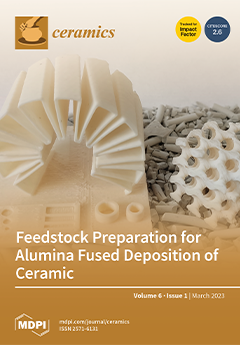Fine powders of brushite CaHPO
4·2H
2O, ardealite Ca(HPO
4)
x(SO
4)
1−x·2H
2O (Ca(HPO
4)
0.5(SO
4)
0.5·2H
2O), and calcium sulfate dihydrate CaSO
4·2H
2O—all containing sodium chloride NaCl as a reaction by-product—were synthesized from 0.5 M aqueous solution of calcium chloride CaCl
2, sodium hydrophosphate Na
2HPO
4 and/or sodium sulfate Na
2SO
4. Powder of ardealite Ca(HPO
4)
x(SO
4)
1−x·2H
2O (Ca(HPO
4)
0.5(SO
4)
0.5·2H
2O) was synthesized by precipitation from aqueous solution of calcium chloride CaCl
2 and mixed-anionic solution simultaneously containing the hydrogen phosphate anion HPO
42− (Na
2HPO
4) and sulfate anion SO
42− (Na
2SO
4). Sodium chloride NaCl, presenting in compacts based on synthesized powders of brushite CaHPO
4·2H
2O, ardealite Ca(HPO
4)
x(SO
4)
1−x·2H
2O (Ca(HPO
4)
0.5(SO
4)
0.5·2H
2O) and calcium sulfate dihydrate CaSO
4·2H
2O, was responsible for both low-temperature melt formation and the creation of phase composition of ceramics. Heterophase interaction of components led to the resulting phase composition of the ceramic samples during heating, including the formation of chlorapatite Ca
5(PO
4)
3Cl in powders of brushite and ardealite. The phase composition of the ceramics based on the powder of brushite CaHPO
4·2H
2O containing NaCl as a by-product after firing at 800–1000 °C included β-Ca
2P
2O
7, and Ca
5(PO
4)
3Cl. The phase composition of ceramics based on the powder of ardealite Ca(HPO
4)
x(SO
4)
1−x·2H
2O (Ca(HPO
4)
0.5(SO
4)
0.5·2H
2O) containing NaCl as a by-product after firing at 800 and 900 °C included β-Ca
2P
2O
7, CaSO
4, and Ca
5(PO
4)
3Cl; after firing at 1000 °C, it includedCaSO
4, Ca
5(PO
4)
3Cl and Ca
3(PO
4)
2/Ca
10Na(PO
4)
7, and after firing at 1100 °C, it included CaSO
4 and Ca
5(PO
4)
3Cl. The phase composition of ceramics based on powder of calcium sulfate dihydrate CaSO
4·2H
2O containing NaCl as a by-product after firing at 800–1100 °C included CaSO
4 as the predominant phase. The phase composition of all ceramic samples under investigation consisted of biocompatible crystalline phases with different abilities to biodegrade. For this reason, the created ceramics can be recommended for testing as materials for treatment of bone defects using regenerative medicine methods.
Full article





